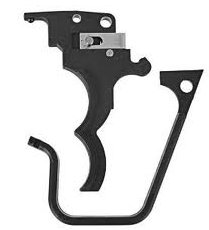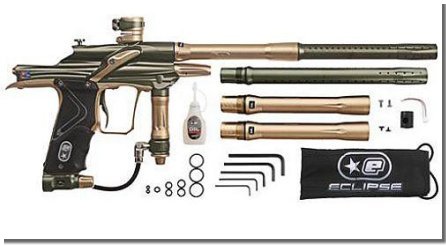Advanced Paintball Weaponry - The Best Markers & Guns
You'll always fall in love with your very first paintball gun. It'll serve you loyally and well for dozens of games, and it'll reliably get you out of some really tight spots.
That said, there will come a time when you're ready to move on.
You'll feel the lure of something better, something sexier, and something more advanced and high-tech.
Maybe you'll get shot up by someone with a really tricked out gun, and you'll wonder where they got it. You'll wonder what else is out there to improve your game. And then you'll start to look...
Here's where paintball gets crazy, because the marker you use really does add to your overall level of game play.
So can owning a high-end paintball actually gun make you a better player?
Sorry to burst a few elitest bubbles, but the answer is a resounding YES. Anyone who says differently is just talking shit, probably because they themselves have been shot up by an unseasoned rookie with a really good gun (or they can't afford to trick out their own weapon at the moment).
Nothing beats good paintball play, but even beginner-level paintballers are made better when their gun shoots more reliably, accurately, and on target.
Guns can be upgraded from tip to tail, top to bottom, inside and out. From barrel to grip, hopper to trigger, you can turn your paintball marker into a custom masterpiece of a personalized weapon that fits your hand like a glove.
There are lots of factors involved in making a paintball gun into a high-end marker, and the bigger ones are listed below:
Upgrading Paintball Barrels

All paintball guns come with a barrel. Yet the barrel is one of the first things players change out, when customizing or upgrading their paintball marker.
To keep things simplistic, barrel length determines accuracy. A longer barrel always shoots straighter, and the ball is more on target when it leaves the barrel tip.
From there, things get more complicated. Barrels can be made of steel, aluminum, or even clay enamel. Steel has the advantage of being smooth (less friction for the ball) and more durable. Aluminum is lighter, cheaper, and can be anodized with all kinds of cool colors, patterns, and styles.
Barrels have holes drilled through them known as 'ports'. Most barrel tips are ported to allow for even airflow, and to reduce shot noise (especially sniper barrels). Sometimes the entire length of the barrel will be ported to create a rifling effect on the ball.
There's tons to know about selecting the right type of paintball barrel for your gun, or to fit your own playing style. Click here to learn lots more about paintball barrels.
Paintball Marker Compressed Air Tanks
All paintball guns run on compressed air. CO2 (Carbon Dioxide) has been commonly used for a very long time, but gradually more and more players have switched over to N2 (Nitrogen gas).
The differences between the two are pretty big. CO2 is fine for warm weather paintball, but in colder weather it tends to create a fog or mist that can obstruct the balls as they leave the barrel. Under very rapid firing, the CO2 tank gets noticably cooler, creating condensation in and around the gun. This especially effects gun performance once it hits the barrel.
N2 is cleaner, and easier to work with. Nitrogen gas tanks also have more accurate pressure gauges, allowing you to know how many more shots you have before you need a refill.
No matter which system you go with, your air tank will generally screw into the back of your paintball gun. Bigger tanks allow you to fire more shots (and play more games) before going empty. Smaller tanks mean more trips to the fill station, but make the gun easier to carry and handle.
External tank systems are great also; they allow you to wear the tank on your back, keeping your gun light and manueverable. A coiled air line must trail between the tank and the gun however, and if you're not careful it can get tangled on a branch as you play the game.
As with everything else in paintball, choosing the right compressed air tank is a matter of personal preference. Click here to learn lots more about air tanks.
Paintball Hoppers & Ball Loaders
Believe it or not, your hopper is very important. Not only does it hold your ammo, but it's responsible for feeding the balls into the gun itself... hopefully without jamming up.
Paintball hoppers come in a wide variety of shapes, stypes, and sizes. The more paintballs it can hold, the more you can obviously shoot without having to reload. But that's just the half of it.
The most basic hopper is a simple gravity-fed device. Balls fall straight downward, one at a time, into the firing chamber of your gun. Each time the trigger is pulled, another ball advances downward, and the other balls in the hopper jockey for position to be next in line.
It's all that jockying for position that can really screw things up. If two balls try falling through the hole at the exact same time, they could get stuck against each other... leaving the firing chamber empty and you launching nothing but a burst of compressed air at your next opponent.
For this reason, paintball hoppers come with laser-activated electronic ball advancing systems. Most run on an external battery; a laser determines whether or not a ball is in the "on deck" position to be fired next. If not, a turnstile-type wheel is motorized to bring a ball forward and into position. In this way, you should always have a ball ready to be fired.
Hoppers can be physically designed to deflect paintballs, as well. Your hopper is the most exposed part of your gun, and if a ball breaks against it you're out.
There are wedge-shaped hoppers made specifically so balls will bounce rather than break, and there are detachable neoprene hopper covers you can buy to soften the impact of incoming ammo (or camouflage your hopper). Click here to learn lots more about paintball hoppers.
Electrostatic Triggers & Double Trigger Options
You wouldn't think the trigger of your gun all that important, right? But then you'd be wrong.

Low-end or starter paintball markers will have a manual trigger. Each time you pull it, the gun will fire, and the trigger will spring back to the original firing position.
It's this 'springing back' part of the process that slows you down. For this reason, electrostatic trigger systems were designed for paintball. Just the slightest touch of the trigger now sends a ball down range, and gently tapping the trigger in rapid succession will fire paintballs almost like a fully automatic weapon.
Double-triggers are also sold, allowing you to alternate back and forth between two fingers (kind of like playing the drums). This speeds up the process of shooting when incorporating an electrostatic trigger into your paintball gun. Most modern markers now come with double triggers.
Aftermarket Paintball Grips & Grip Covers
Don't like the grip on the handle of your gun? Change it out.
For every major paintball gun manufacturer there are aftermarket handle grips available. Choose from rubberized pads (for better gripping during play) to pistol-grip designs that feel great in your hand. Or pick something that matches the colors and patterns on your gun... it's really up to you. Grips are more aesthetic than anything else, but they can be functional.
Customizing Your Paintball Marker
In the end, you gun can be as stock (standard) or custom as you see fit. Some players go for look, others for performance, and some for a mixture of both.
The good news is there are LOTS of great after-market equipment you can use to trick out or even build your own paintball gun for scratch.
And while some of the higher-end, pro-performance stuff might cost a lot, there are some very cool lesser-priced options too, when it comes to fixing your gun up to look (and performa) exactly the way you want it.
Check out PaintballOnline.com for some really great deals on guns, equipment, and protective wear for on the paintball field and off.
They run weekly deals on certain items, and they offer free shipping on orders of $100 or more.

